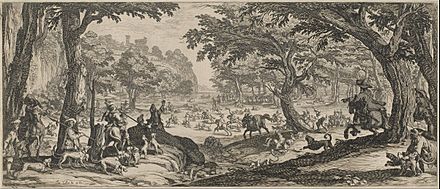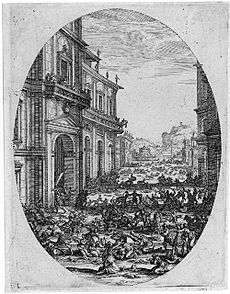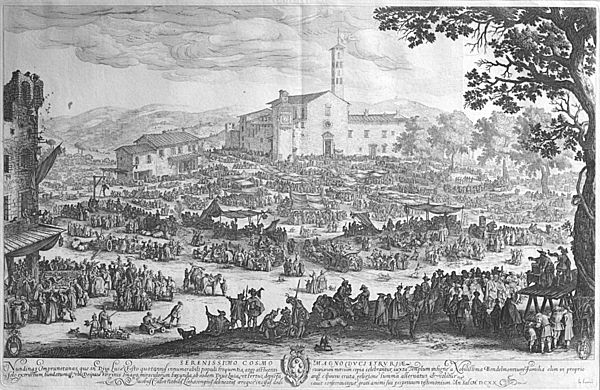Jacques Callot facts for kids

Jacques Callot (born around 1592 – died 1635) was a talented artist from the Duchy of Lorraine. This was an independent state located near modern-day France and Germany. He was a master of making prints and drawings.
Callot played a big role in developing the art of the old master print. He created over 1,400 etchings. These artworks showed scenes from his time, like soldiers, clowns, and people from the court. He also made many religious and military pictures. Many of his prints featured beautiful landscapes in the background.
Contents
Life and Training
Jacques Callot was born and died in Nancy. This city was the capital of Lorraine, which is now part of France. He came from an important family; his father worked for the Duke's court. Callot often mentioned his noble background in his artworks.
When he was about fifteen, he started training with a goldsmith. But soon after, he traveled to Rome, Italy. There, he learned how to make engravings from a French artist named Philippe Thomassin. Later, he likely studied etching with Antonio Tempesta in Florence, Italy. He lived in Florence from 1612 to 1621.
We know of more than 2,000 drawings he made to prepare for his prints. However, no paintings by him are known. This suggests he probably never trained as a painter.
While in Florence, he became an independent artist. He often worked for the powerful Medici family. After the death of Cosimo II de' Medici in 1621, Callot returned to Nancy. He lived there for the rest of his life. He also visited Paris and the Netherlands later.
He received art jobs from the courts of Lorraine, France, and Spain. Publishers, mainly in Paris, also hired him. Even though he stayed in Nancy, his prints were sold all over Europe. Famous artists like Rembrandt even collected his works.
Clever Art Techniques
Callot's art techniques were amazing. He also made important improvements to how prints were made.
The Échoppe
He invented a special tool called the échoppe. This was a type of etching needle with a slanted, oval tip. This tool allowed artists to make lines that looked thicker in some parts and thinner in others. This was similar to how engravers could make their lines.
Better Etching Ground
Callot also seemed to create a better recipe for the "etching ground." This is a protective coating put on a metal plate. The artist scratches through this ground to create the image. Callot used a type of varnish instead of a wax-based formula.
This new ground allowed lines to be etched deeper into the plate. This meant the plate could be used to make more prints before wearing out. It also greatly reduced the risk of "foul-biting." Foul-biting happens when acid accidentally gets through the ground where it shouldn't. This causes unwanted spots or blotches on the print. Before Callot's invention, artists risked ruining their detailed work. Now, etchers could create very detailed images, just like engravers. Callot used these new possibilities very well.
Stopping-Out Technique
He also used a technique called "stopping-out" in a more advanced way. With this method, the artist lets acid lightly etch the whole plate. Then, they cover parts of the image they want to keep lighter with more ground. After that, they put the plate in acid again. This allows other parts to be etched deeper.
By carefully controlling this process, Callot created amazing effects of distance, light, and shadow. Most of his prints were quite small, usually about 15 centimeters (six inches) on their longest side.
One of Callot's fans, Abraham Bosse from Paris, shared Callot's new ideas across Europe. He wrote the first published guide on etching, which was translated into many languages.
Miseries of War
Callot's most famous artworks are two series of prints called "The Miseries and Misfortunes of War." The larger series, Les Grandes Misères de la guerre, has 18 prints and was published in 1633. The earlier, smaller series is called Les Petites Misères.
These images show soldiers causing destruction, burning towns and villages. They also show soldiers being arrested and punished by their leaders. Some survivors become disabled beggars. At the end of the series, the generals are rewarded by their king.
In 1633, the year the larger series came out, Lorraine was invaded by the French during the Thirty Years' War. Callot's art, along with Francisco Goya's Los Desastres de la Guerra (The Disasters of War), is seen as a powerful statement against the cruelty of war. Goya even owned a set of Callot's prints.
Grotesque Dwarves
Callot also created a series of prints called "Grotesque Dwarves." These funny, exaggerated figures later inspired companies like Derby porcelain to make pottery figures. These figures were known as "Mansion House Dwarves" or "Grotesque Dwarves." The "Mansion House" name came from a father and son who wore large hats with advertisements while walking around the Mansion House in London.
Varie Figure Gobbi – Series of 21 etchings, 1616
Other Famous Works
- A large series showing commedia dell'arte characters. These are called Balli di Sfessania. They are drawn in a simple, funny style from his time in Florence.
- Series about the Lives of Christ and Mary.
- Series about the story of the Prodigal Son.
- The Giant Tifeo beneath Mount Ischia (1617).
- The Fair at Impruneta (1620).
- The Fair at Gondreville (1624).
- The Temptation of St Anthony (1635, Fitzwilliam Museum). Temptation of Saint Anthony
See also
 In Spanish: Jacques Callot para niños
In Spanish: Jacques Callot para niños












